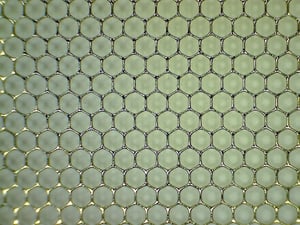
As the world’s population continues to climb, so does the need to conserve water. Environmental responsibility demands water-efficient industrial processes, and commercial water users must make better use of costly resources to serve the growing number of consumers.
Fortunately, advancements in water treatment technology are allowing industrial users to meet the growing demand for conservation. From ultrafiltration to reverse osmosis to centrifuge, there are a variety of ever-improving methods for companies to clean and re-use water.
Because so many industries rely on water, most commercial entities will need to implement at least a few of these technologies. Below are a few key facts regarding conservation efforts, current technologies and cutting-edge developments.
Conversation Concerns
Why the buzz over water conservation? Environmental protection ranks it among the top concerns. The proof is in the statistics. In the United States alone, the EPA notes the use of drinking water in the past half-century has tripled, even through the country’s population has only doubled.
According to the United Nations, over 80 percent of all wastewater flows back into lakes, rivers and other bodies of surface water. Not only does this process contaminate drinking water, it also leads to the loss of valuable, recoverable nutrients and industrial materials.
Pollution aside, growing and rapidly industrializing populations simply need to make more efficient use of a finite resource. Once primarily used for agriculture, water is now used extensively in energy and other industries, often as a means of cooling equipment. All told, industrial water use has withdrawn 5 to 10 percent of the world’s fresh water per year since 1999.
Not surprisingly, governments worldwide have enacted a variety of conservation measures. In the United States, these measures include the Clean Water Act, Resource Conservation and Recovery Act and Safe Water Drinking Act, all of which have created considerable compliance requirements.
Bottom-Line Benefits
Fear of penalties isn’t the only reason for companies to reuse water, however; nor is concern for the environment. From a strictly financial standpoint, saving and reusing water allows for a significant reduction in operational costs. Disposing of wastewater, coolant and other water-based liquids is costly, as is replacing clean water. Recycling these materials in-house improves profitability by reducing the costs of maintenance, disposal and compliance with efficiency standards.
The Water Treatment Process
Most wastewater treatment operations involve four key processes: coagulation, sedimentation, filtration and disinfection. During coagulation, positively charged chemicals are added to water to neutralize dirt and other particles. These particles bind together to form a substance called floc which, in turn, attracts larger particles.
Depending upon their size and density, those floc particles will either rise to the top or sink to the bottom of a water tank, allowing for easy removal. What’s left is a cleaner tank of wastewater, but that water still contains a variety of smaller impurities. Filtration is the process that removes those impurities.
Current Technologies
With the growing demand for wastewater treatment, a variety of filtration technologies have become commonplace, each with its pros, cons and ideal applications.
Bed Filters
Bed filters feature deep beds of materials chosen specifically to remove a certain type of impurity. For instance, sand is used for removing dirt in municipal wastewater; walnut shells are used to catch oil droplets; and activated carbon captures heavy metals. Most bed filter systems also feature a backwash cycle, which minimizes maintenance and eliminates the need to replace filter media.
Cartridge Filters
A low-cost alternative to bed filters, a cartridge filter is a single piece of filtering material wrapped around a perforated cylinder. As water passes through the cylinder, it is forced through the filtering medium. Once a filter has become saturated with contaminants, the cylinder assembly is simply discarded and replaced.
Filter Presses
Unlike traditional filters, a filter press removes water from solid materials. This inventive process is useful for high-concentration applications where water samples are too thick with contaminants to be filtered through conventional means. Similar to a French press used for making coffee, a filter press operates by applying pressure to a slurry mixture, extracting the water. The concentrated, caked contaminant material can then be easily recycled or disposed of.
Cutting-Edge Solutions
In addition to some of the more common types of filtration devices, several newer, cutting-edge solutions have made their way onto the market.
Ultrafiltration Systems
Similar to filter presses, ultrafiltration (UF) uses pressure to push highly concentrated liquids through a membrane, which removes emulsified oils, metals and other high-molecular weight materials. Given their high efficiency and ability to recycle water-and-soap solutions, users have reduced their wash water and detergent costs by up to 75 percent, and their waste disposal costs by up to 90 percent!
Vacuum Evaporation and Distillation
By dramatically accelerating the natural evaporation process, vacuum systems offer the fastest possible water recovery rates. Water is efficiently evaporated in a vacuum chamber at a low temperature, leaving behind almost every type of contaminant. That water can then be quickly cooled, condensed and reused.
Reverse Osmosis
Reverse osmosis (RO) systems remove dissolved impurities with a semipermeable membrane. Pressure is applied in the opposite direction in which osmosis would normally occur, causing water to flow through the membrane, towards the side of lower contaminant concentration. In general, RO is ideal for applications requiring demineralization and deionization.
Improving Sustainability and Productivity with Switzer
Each one of these filter types has its benefits and drawbacks, and not all will be right for your specific water treatment applications. However, one thing these technologies have in common is their need for durable, high-precision metal parts.
Fortunately, Switzer’s design and manufacturing services can help you create the ideal filtration systems for your operation. We leverage innovation and expertise to design high-precision metal filters and screens, which can be scaled and manufactured to meet your exact specifications. Contact us today to learn how our parts can help fuel the efficiency of your industrial filtration systems.
.png)

